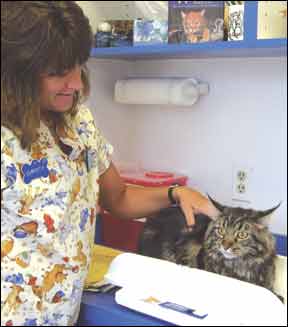At first, the owner worried that her cat Misket had worms. Her 11-year-old pet had a ravenous appetite, yet she appeared to be losing weight and her coat looked dull and unkempt. The veterinarian took a blood test and came up with a surprising diagnosis to her owner: hyperthyroidism, or overproduction of thyroid hormones.

288
Feline hyperthyroidism tends to occur in elderly cats; 95 percent of the cats that develop this disease are older than eight and the mean age of the victims is about 12 years, according to John F. Randolph, DVM, professor of medicine in the section of small animal medicine at Cornell’s College of Veterinary Medicine.
This disease is caused by a tumor (or tumors) in the thyroid gland. Fortunately, these growths are rarely malignant. “The great majority of the tumors — about 98 percent — are benign,” says Dr. Randolph, who is board-certified by the American College of Veterinary Internal Medicine. Hyperthyroidism can involve one or both lobes of your cat’s thyroid; about 70 percent of the cases involve both lobes.
In a normal cat, the thyroid gland functions as a metabolic regulator — just as a thermostat regulates the activity in the furnace of your home. When the thyroid gland produces an excess of thyroid hormones, thyroxine (T4) and triiodothyronine (T3), it essentially cranks up the furnace, thereby accelerating metabolic activity in your cat. A deficit of these hormones slows the animal’s metabolic rate, resulting in sluggish, lethargic behavior.
Typically, the signs of feline hyperthyroidism include weight loss, ravenous appetite, increased thirst, increased urination and hyperactivity. “A cat that tends to pace, is restless and cries a lot may have hyperthyroidism,” explains Dr. Randolph. Other signs can include vomiting, diarrhea and a poor or unkempt coat. In some cases, a cat can develop heart problems, such as murmurs, abnormal rhythms, rapid heart rate and even heart failure.
In most cats, hyperthyroidism can be diagnosed with a simple blood test that measures the level of thyroid hormones in the cat’s blood. A clearly elevated level of thyroid hormones is an indication of hyperthyroidism. “Occasionally, you will encounter a cat with hyperthyroidism where the thyroid hormone levels are not elevated,” says Dr. Randolph. In these cases, more complicated testing can be performed to confirm the diagnosis.
Therapies. What can you do if your cat develops hyperthyroidism? There are three different therapies that can be utilized: medical management with antithyroid drugs, surgery or radioactive iodine.
Medical management involves administering drugs that inhibit the production of thyroid hormones in the cat’s thyroid gland. The most common drug used for this therapy is methimazole (also known as Tapizole®). “This drug does nothing to destroy the tumor, but it blocks production of thyroid hormones in the tumor tissue. As a result, the clinical signs associated with hyperthyroidism subside,” explains Dr. Randolph.
An obvious drawback to this treatment is that it does not cure the underlying condition, and the drug must be administered orally to your cat for the rest of her life. Sometimes, methimazole will create side effects such as poor appetite, vomiting, scratching at the face and neck, liver toxicity, or blood cell abnormalities, such as low platelet counts, white blood cell numbers or anemia. If the drug is discontinued, the thyroid hormone levels will begin to elevate and the signs of the disease will reappear.
Another common therapy for hyperthyroidism is the surgical removal of the offending thyroid tumor or tumors. This approach will usually cure the underlying problem, but it also means that your cat must undergo anesthesia and surgery, which can be difficult for some older cats.
Complications associated with this surgery include inadvertent damage to or removal of the parathyroid glands. These are located adjacent to and within the lobes of the thyroid gland, and they regulate the balance of calcium in the body. “When these glands are damaged or removed, the calcium level can get dangerously low,” cautions Dr. Randolph. Fortunately, calcium levels can be adjusted by certain drugs and supplements – and spontaneous recovery usually occurs with time.
Radioactive Iodine Treatment. “This treatment is probably the optimal treatment for your hyperthyroid cat, but the main drawback is the relatively limited availability of nuclear-medicine facilities,” says Dr. Randolph. When this treatment is used, radioactive iodine is administered to the cat by injection. Iodine is used because it is taken up by, and localized in, the thyroid gland. The radioactivity destroys the rapidly growing tumor cells, usually without damaging the rest of the thyroid gland.
“It usually won’t damage the parathyroid gland; it just damages the overactive thyroid tissue,” explains Dr. Randolph. “This is accomplished without the complications and side effects of surgery or antithyroid drug therapy.”
Unfortunately, not all veterinarians are able to provide this treatment, and use is limited to specially licensed institutions. “We have a radioiodine treatment center for cats at Cornell’s College of Veterinary Medicine. There are other centers in New York City and throughout the country that are licensed to treat cats with radioactive iodine,” says Dr. Randolph.
The treatment also requires a quarantine period of one to two weeks, during which the treated cat has limited close human contact. The cat will be sent home once the radioactivity subsides to a level where it is both safe and acceptable to discharge the cat to his family’s care.
Hyperthyroidism is a disease that can strike any older cat. However, if it is properly diagnosed and treated, this endocrine disorder can be managed successfully. “When the treatment is successful, you will see the cat put weight back on and its coat will improve. That is a very exciting, happy situation,” says Dr. Randolph.



